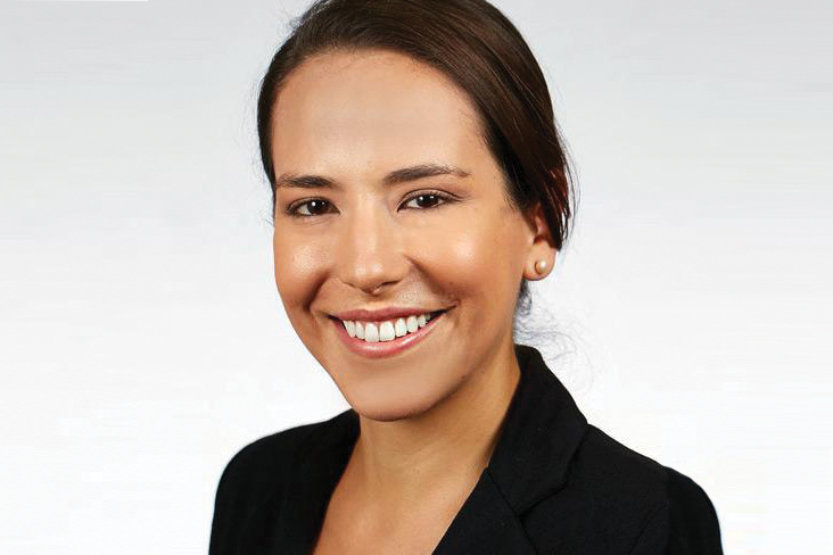Research Risk-taker
 Markita Landry (Image courtesyof Markita Landry)
Markita Landry (Image courtesyof Markita Landry) YOUNG ALUMNI AWARD
Submitting your first paper for publication is a nerve-wracking rite of passage for any Ph.D. student. While pursuing her doctorate in chemical physics at Illinois with U of I Professor of Physics and Biophysics Yann Chemla, Markita Landry, PHD ’12 LAS, was floored when her inaugural paper came back from review with the following comment: “This work is perfect. Publish as is.”
“That was a really nice way to kick off my career,” Landry says. “It set a high bar for everything that came afterward.”
Landry has continually raised the bar since, earning 20 early career awards from prestigious institutions ranging from the Sloan Foundation to the Defense Advanced Research Projects Agency and the Society of Professional Hispanic Engineers. She is an ideal candidate for the inaugural University of Illinois Young Alumni Award. “It’s an honor to be recognized by the institution that made me who I am today,” she says.
Landry has forged numerous high-profile partnerships since establishing the Landry Lab in the Dept. of Chemical and Biochemical Engineering at the University of California, Berkeley in 2016. The lab’s work attracted funding from the Chan-Zuckerberg Biohub (funded by Facebook CEO Mark Zuckerberg and his wife, Priscilla Chan), which encourages awardees to take risks and pursue exciting ideas.
Landry’s risky, exciting idea is a cutting-edge tool that she developed called a single-walled carbon nanotube (SWNT). This rigid cylinder of carbon measures one nanometer in diameter by 500 nanometers in length—about 10,000 times thinner than a human hair. The nanotubes’ size and structure allow them to pass through seemingly impenetrable barriers.
For example, the Landry Lab is using SWNTs to safely breach a plant’s tough cell walls and securely ferry CRISPR (clustered regularly interspaced short palindromic repeat) gene-editing tools into plant cells for potential genetic engineering. She focuses on that work as an investigator for UC–Berkeley’s Innovative Genomics Institute, whose president, Jennifer Doudna, won the Nobel Prize in Chemistry for CRISPR.
SWNTs also emit near-infrared light, which can pass through blood, water, tissue and skin with minimal interference. That quality makes SWNTs a promising nanosensor for previously unexplored parts of the body—in particular, as a way to determine how neurotransmitters work in the brain.
With the Chan-Zuckerberg funding, Landry is developing a SWNT sensor that fluoresces in the presence of dopamine, a neurotransmitter critical in psychiatric ailments, addiction and neurodegenerative illnesses such as Huntington’s disease. “For example, we might be able to see how cocaine addiction changes brain chemistry and rewires the brain,” she explains. “In our studies of Huntington’s disease, we could see when dopamine-expressing neurons lose the ability to communicate chemically before they physically start to atrophy, allowing us to catch that disease progression earlier.”
SWNT sensors could be designed to identify a wide range of biological molecules. When the pandemic struck, the Landry Lab swiftly swung into action to develop a nanosensor to detect the protein responsible for COVID-19. Landry and her team have filed for a provisional patent and are testing their sensor on nasal fluid and saliva samples with the goal of incorporating the sensor into a rapid-detection test. “There’s certainly a sense of urgency to this work, and it is the single most collaborative project we’ve had in the lab,” she says.
Landry’s collaborations across the UC–Berkeley campus and beyond have been key to her success, especially considering that she had never conducted neurological research, let alone biological research, before launching her lab. But she was well prepared for cultivating those productive partnerships; during her Ph.D. program at Illinois, she also squeezed in a Certificate in Business Administration. “Doing the science is only half the battle,” she says. “The other half is working with students, faculty and collaborators. That requires skills different from those we learn in science textbooks. The program helped me think about how I could productively pursue my research career, manage large teams, help my students achieve their career goals and work with so many people speaking different ‘languages’ from so many different fields.”
The University of Illinois Alumni Association presented its annual Alumni Awards as part of “virtual” Homecoming Week 2020, Nov. 29—Dec. 5. The UIAA honored the recipients of two Alumni Achievement Awards, the recipient of the Lou Liay Spirit Award, and recognized two Honorary Alumni. In addition, two new awards were presented, one recognizing an outstanding Young Alumni and the other championing noteworthy efforts to promote Diversity and Inclusion.
To see all recipients of the 2020 University of Illinois Alumni Awards, click here.

